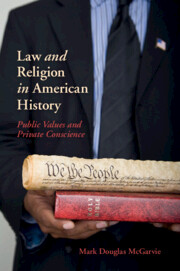Book contents
- Frontmatter
- Contents
- List of Illustrations
- Preface
- Acknowledgments
- Prologue: Colonial America Perpetuates State Religion
- 1 Revolution in Thought and Social Organization: The Legal Hegemony of Jeffersonian Liberalism, 1776–1828
- 2 A Christian Counter-revolution and a New Vision of American Society, 1828–1865
- 3 Regulating Behavior and Teaching Morals: The Uses of Religion, 1865–1937
- 4 The Rights Revolution, 1937–2015
- Epilogue: The Signifi cance of History and a Reconsideration of Original Intent
- Bibliographic Essay
- Index
4 - The Rights Revolution, 1937–2015
Published online by Cambridge University Press: 05 July 2016
- Frontmatter
- Contents
- List of Illustrations
- Preface
- Acknowledgments
- Prologue: Colonial America Perpetuates State Religion
- 1 Revolution in Thought and Social Organization: The Legal Hegemony of Jeffersonian Liberalism, 1776–1828
- 2 A Christian Counter-revolution and a New Vision of American Society, 1828–1865
- 3 Regulating Behavior and Teaching Morals: The Uses of Religion, 1865–1937
- 4 The Rights Revolution, 1937–2015
- Epilogue: The Signifi cance of History and a Reconsideration of Original Intent
- Bibliographic Essay
- Index
Summary
It is easy to perceive the last seventy-five years as encompassing so many extreme vicissitudes in the relationship between law and religion that they are better seen as constituting several distinct periods than a continuous one. Yet, these years can largely be defined through coincident changes in cultural attitudes and law that have reshaped the country's understanding of religious freedom. A new conception of rights as both created instead of natural and communal instead of individual, deriving from various permutations of Pragmatist thought, influenced the federal law on religion. Beginning in the late 1930s and 1940s, the Supreme Court used the Fourteenth Amendment as the basis for asserting these rights to address state actions threatening First Amendment protections of religion. The Court's early decisions separated the religion clauses, creating two somewhat conflicting and specific proscriptions on government action from what had been a general affirmation of a protected right to freedom of conscience. Yet, the Court's recognition of rights as belonging to groups served as the central legal formulation in the development of its new jurisprudence. Both the Court's assertion of group rights and its separation of the free exercise and establishment clauses have created tremendous confusion and a huge increase in political concern over the nature of freedom of conscience and the extent to which separation of church and state is necessary to protect it.
In recognition of the political rights of Christians as a group, the Court from the 1940s through the end of the century gradually moved from a doctrine of neutrality between religious and secular goals for society to a position of accommodation of policies and practices endorsed by religious groups as means of achieving their societal goals. At the same time, intellectual and cultural movements within American society increased awareness of group identities as stronger and potentially more important factors than protections of individual rights in preserving democratic self-government.
New Bases for Christian Activism Emerge, 1937–1960
Economic Rights versus Civil Rights
In his 1941 State of the Union Address, President Franklin D. Roosevelt asserted the legitimacy of Americans’ expectations of freedom of speech, freedom of worship, freedom from want, and freedom from fear. However inspiring Roosevelt's message may have been, it was also an ahistorical assertion.
- Type
- Chapter
- Information
- Law and Religion in American HistoryPublic Values and Private Conscience, pp. 127 - 192Publisher: Cambridge University PressPrint publication year: 2016

